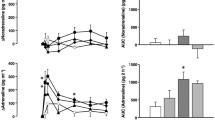Abstract
The contributions of circulating angiotensin II (Ang II) and catecholamines to cardiovascular control in the spiny dogfish were investigated by monitoring the effects of exogenous and endogenous dogfish [Asn1, Pro3, Ile5]-Ang II (dfAng II) on plasma catecholamine levels and blood pressure regulation. Bolus intravenous injections of dfAng II (30–1200 pmol kg−1) elicited dose-dependent increases in plasma adrenaline and noradrenaline concentrations, caudal artery pressure (P CA), and systemic vascular resistance (R S), and a decrease in cardiac output (Q). Similar injections of Ang II in dogfish pre-treated with the α-adrenoceptor antagonist yohimbine (4 mg kg−1) also elicited dose-dependent increases in plasma catecholamine levels yet the cardiovascular effects were abolished. Dogfish treated with yohimbine were hypotensive and had elevated levels of plasma Ang II and catecholamines. Intravenous injection of the smooth muscle relaxant papaverine (10 mg kg−1) elicited a transient decrease in P CA and R S, and increases in plasma Ang II and catecholamine levels. In dogfish first treated with lisinopril (10−4 mol kg−1), an angiotensin converting enzyme inhibitor, papaverine treatment caused a more prolonged and greater decrease in P CA and R S, an attenuated increase in plasma catecholamines, and no change in plasma Ang II. By itself, lisinopril treatment had little effect on P CA, and no effect on R S, plasma Ang II or catecholamines. In yohimbine-treated dogfish, papaverine treatment elicited marked decreases in P CA, R S, and Q, and increases in plasma Ang II and catecholamines. Among the three papaverine treatments, there was a positive linear relationship between plasma Ang II and catecholamine concentrations, and the cardiovascular and hormonal changes were most pronounced in the yohimbine + papaverine treatment. Therefore, under resting normotensive conditions, while Ang II does not appear to be involved in cardiovascular control, catecholamines play an important role. However, during a hypotensive stress elicited by vascular smooth muscle relaxation, Ang II indirectly contributes to cardiovascular control by dose-dependently stimulating catecholamine release.
Similar content being viewed by others
Author information
Authors and Affiliations
Additional information
Accepted: 24 February 1999
Rights and permissions
About this article
Cite this article
Bernier, N., Gilmour, K., Takei, Y. et al. Cardiovascular control via angiotensin II and circulating catecholamines in the spiny dogfish, Squalus acanthias. J Comp Physiol B 169, 237–248 (1999). https://doi.org/10.1007/s003600050217
Issue Date:
DOI: https://doi.org/10.1007/s003600050217




